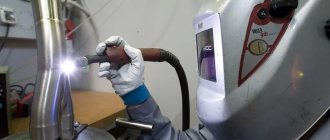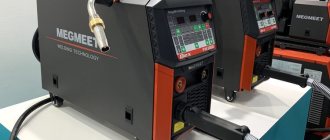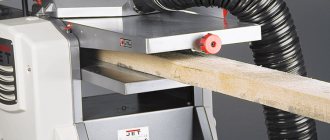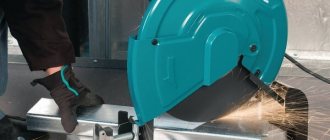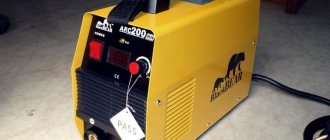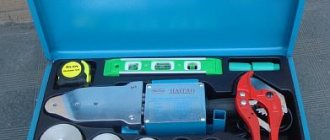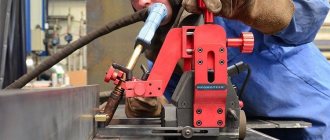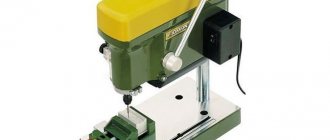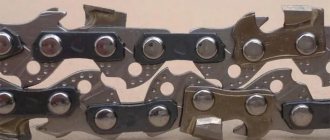Types and features of devices
Depending on the tasks to be solved, as well as the power allocated, generators are classified into several categories.
Gasoline devices for summer cottages are among the most common types of devices. They are mini power plants capable of providing power up to five kilowatts.
Their distinctive feature is their low weight and small dimensions. In this regard, they are convenient to transport.
Such devices do an excellent job of providing a cottage, private home or small workshop with electricity during power outages and failures. Thus, this type of equipment will be the best household option.
Generator for welding work.
A gasoline welding generator is a type of unit designed to produce electricity with a power of up to ten kilowatts. This equipment can easily cope with long-term loads and can provide uninterrupted operation for eight hours.
When choosing such a device, you should pay special attention to the motor manufacturer. There are often cases of rapid failure of this unit due to poor build quality.
Considering the battery life, an important criterion is such a parameter as the volume of the fuel tank. If its capacity is insignificant, then the duration of uninterrupted electricity production will be automatically limited by the amount of fuel.
The presence of high-quality noise insulation and an electric starter are also important characteristics that make work more comfortable and enjoyable. Of course, if finances allow, it is better to give preference to units with the specified elements.
The most modern overhead valve devices are even compared to a diesel welding generator in terms of power produced. Such installations are characterized by low noise levels, high performance and durability.
It makes sense to purchase a gasoline unit only in cases where you plan to use inverter welding and other devices for a long time without access to the network. The most common case is construction work. In this case, it is simply impossible to do without mini power plants.
There are also more powerful devices that can provide power of about twenty kilowatts or more. They are equipped with automatic start and are massive, large-sized stationary units.
Features of the circuits
The characteristic defines the permissible functionality and control. They are presented in many specific modifications with different characteristics. Many manufacturers use their own developments at the design stage.
Such introductions are relevant for the average consumer, since they have the opportunity to select a product based on their tasks and acceptable budget.
Depending on the scheme used, they are divided into:
- with a falling external characteristic;
- with a rigid, gently sloping external characteristic;
- universal.
The most popular ones with decreasing external characteristics. They use the following scheme:
- with independent excitation;
- with self-excitation.
Device
Choosing the right generator for an inverter welding machine or other type of welding is only possible if the operating principle of the device and its design are fully understood.
The welding generator device is a frame structure with an engine and an alternator mounted on it through shock absorbers. Torque is transmitted to the unit’s engine through a special coupling from the alternator rotor.
The result is a three-bearing arrangement based on bearings on the rotor and the end of the crankshaft. The third bearing is located at the output of the engine power take-off shaft.
The following elements are also placed on the device body:
- current indicator;
- sockets;
- buttons or toggle switches that allow you to change modes;
- circuit breaker;
- connectors for welding cables;
- regulators.
When purchasing such devices, you should understand that they are capable of producing a certain amount of electricity. In this regard, it is important to pay attention to the power of the generator so that its operational capabilities coincide with the requirements of the user.
Based on functional parameters, the following types of devices are distinguished:
| Device type | Characteristic |
| Transformers | Characterized by relatively low cost. Convenient and small-sized devices that provide alternating current. |
| Rectifiers | Units producing direct current. Used for processing stainless steel parts. |
| Inverter type | Devices with high-precision mode settings. Used for operation in automatic and argon-arc modes. |
Depending on the type of fuel used, gasoline and diesel welding transformers are distinguished. The first ones are characterized by low power, but their price is also affordable. It is impossible to use such devices for long-term operation in difficult conditions. The best area of application for such generators is various small household jobs.
Electrical circuit of a commutator welding generator.
Diesel options are reliable and have a wide range of power options. In addition to a long working life, these units boast the ability to operate under the influence of low temperatures.
Of course, the price of these devices is significantly higher. However, if the generator is used frequently, the cost pays off fairly quickly. Which device option to choose is up to the user to decide. Here you need to start only from the assigned tasks and financial capabilities.
How is a generator used for welding compared to a conventional one?
This is possible if the nuances are taken into account when connecting the generating device to the general electrical system of the house. A model of a gasoline electric generator for an inverter welding machine uses a conversion function to remove voltage surges and stabilize waves. These are additional bonuses that extend the period of uninterrupted and reliable operation of equipment that strongly depends on the quality of the received supply voltage: computers, medical equipment, etc.
The inverter type of models is slightly higher in price, but is installed without rectifiers. In the absence of power lines, the power of such devices is sufficient to fully supply a private home with electricity.
Principle of operation
The inverter needs a welding gas generator as a source of voltage necessary for its operation.
The operating principle of a conventional generator is based on the conversion of mechanical energy into electrical energy. The output in such devices is an alternating voltage, characteristic of power surges and fluctuations.
Thus, the productivity and efficiency of the device decreases significantly, and the service life of the device is also reduced.
What kind of generator is needed for a welding machine?
There are two main ways out of the situation:
- use power plants with a significant power reserve;
- use a station that produces a stable voltage.
Both options have their advantages and disadvantages. Thus, the choice must be made based on the characteristics of the work being performed.
What current?
Available on the market:
- D.C. Budget solution for the home. For welding, supports all types of electrodes. The resulting seams are smooth and neat. Cannot be used without a rectifier.
- Variable. The advantages of this category include affordable cost and simple design. Suitable for work where there are no high demands on the quality of seams.
How to do it yourself?
You can make a generator for welding yourself. For these purposes, it is better to use a separate room, for example, a workshop or garage.
The first element with which to begin production is the frame. A corner measuring forty by forty millimeters is perfect for it. After the required length is cut using a grinder, holes are drilled in it for the motor and generator. These elements are secured to the frame with bolts.
It is worth noting that in this situation you can assemble a welding machine from a car generator.
Next comes the installation of wheels to the base of the frame to ensure easy movement. The wheels can be secured by welding or bolts.
Features of welding generators.
The principle of operation of the device is based on the transmission of torque from the motor to the generator, as a result of which a current is generated.
This circuit underlies the operation of each device.
The unit can operate without a gas generator. The generator can also be supplied with mains voltage, which is subsequently converted into the required current for welding.
As you can see, making a welding generator yourself is not difficult. It is also possible to make a welding machine from a laboratory autotransformer.
general information
A welding generator is a portable device with a built-in engine, which is an autonomous source of electricity. Simply put, a welding generator is a compact, autonomous power plant. A generator for inverter welding is useful not only for welding work. It is indispensable in case of frequent power outages in a suburban area and in the absence of electricity in a garage cooperative, for example. Also, a generator for welding with an inverter is necessary when the voltage in the household electrical network is low, when the machine is simply not able to turn on.
The operating principle of a welding generator is extremely simple. The device is a conventional internal combustion engine and a current generator. The engine can be gasoline or diesel. The engine burns fuel, thereby driving the generator, which begins to produce the necessary current.
A welding gasoline or diesel generator is different from a regular generator. Despite the similar principle of operation, only a welding generator is capable of generating sufficient current for manual arc welding. For this reason, you should not use a regular household generator to power the welding inverter.
Also, do not confuse the generator that we are talking about in this article with a welding unit, which is often called a generator. A welding unit is a generator with a welding function, in other words, an autonomous welding machine or a generator and a welding machine in one housing. Such a generator with a welding function is able to work independently, without a welding machine or electricity. And the welding generator discussed in this article simply provides electricity to perform welding work using a third-party welding machine.
What to look for when choosing?
When choosing a generator for a welding machine, it is important to consider some device parameters. For example, it was previously mentioned that a gas generator is incompatible with high-power inverters. This point is due to the inability of such units to compensate for voltage surges.
So how to choose a generator for a welding inverter? This issue has its own nuances that require a competent calculation of the power of the device. In the inverter type, it is equal to the maximum consumption. However, it is worth taking it with a small margin of twenty or thirty percent of the total productivity of the station.
Thus, to find out which generator will power this or that equipment, you should multiply the arc voltage by the maximum current consumed. The marked values are usually given in the operating instructions.
The value obtained as a result of the calculation should be divided by the efficiency factor. This value is the maximum voltage that allows you to select a gasoline generator.
Even taking into account the large power reserve, it is better to choose an inverter-type device. The energy produced by such a device is of higher quality and has less power fluctuations, which is an important criterion in welding.
What engine?
Power plants are classified by engine type. It can run on gasoline or diesel. Each of the groups has its own strengths and weaknesses, and is also aimed at solving a certain type of problem. Knowing the features and nuances of operation will help you make the right choice.
Gasoline
Enjoys well-deserved popularity among consumers. The demand is due to the high quality of the resulting voltage. The result is achieved by uniformly supplying torque to the generator rotor.
The inverter modification effectively copes with welding and solving everyday problems. In addition to reduced fuel consumption, it received a number of nuances that effectively distinguish it from its competitors:
- uniform voltage supply during operation;
- an electronic circuit that reduces drive speed to idle during idle times;
- increase in voltage under load;
- automatic power control significantly reduced fuel consumption compared to analogues.
It is preferable to purchase a gasoline generator with a built-in welding module. Such devices effectively cope with tasks and act as a source of emergency power for the home. Depending on the manufacturer, install:
- Two-stroke engine. A budget solution for models aimed at home use. The drive is not suitable for long-term operation; it gets very hot and has performance limitations.
- Four-stroke engine. Professional powerful equipment with a water cooling system. The drive will last a long time. The only drawback is the cost, which exceeds simple analogues.
The generator received a single-cylinder engine with a power of 8 - 13 hp. With. It is not inferior to walk-behind tractors and simple installations. Starting is carried out by a cable starter. An automatic decompressor is designed to eliminate the problems associated with manually cranking the crankshaft. The component opens the exhaust valve slightly at low camshaft speeds. The manipulations reduce the pressure at the end of the compression stroke. The throttle valve controls the centrifugal governor. A decrease in speed leads to an increase in throttle opening. Wear increases as the governor maintains high speed despite no load.
The generator power, depending on the modification, is 2.5 kW - 14 kW. The capacity of the gas tank ranges from 4 to 25 liters. The maximum generated electric current is 160 - 300 A. Compatible with electrodes with a diameter of up to 5 mm.
Advantages:
- affordable price;
- weight within 50 - 100 kg;
- easy operation;
- There are no problems with starting during frosts.
Flaws:
- short service life from 500 to 3000 hours;
- high fuel consumption;
- the installation requires periodic rest, according to the time specified by the manufacturer (indicated in the instructions).
Diesel
The operating principle is similar to gasoline models. The difference is:
- Placement of the centrifugal regulator. It is built into the fuel pump and controls the flow of flammable liquid.
- The use of voltage is possible subject to the availability of additional equipment.
The stations are designed to perform voluminous work with high load. Users note longer operation compared to analogues. Power indicators are in the range of 6 kW - 16 kW. In stationary models, the performance reaches 80 kW. Categorically not suitable for use at home.
A capacious volumetric tank of 12 - 65 liters is installed on board. The minimum electric current is 160 A, the maximum is 520. Supports electrodes with a diameter of 8 mm.
Advantages:
- long-term operation (40,000h);
- stable work;
- welding under increased loads;
- high efficiency;
- low fuel consumption;
- operation almost throughout the day without interruption.
Flaws:
- there are difficulties starting the engine during frosts;
- heavy (from 100 kg);
- high price;
- intense current wave;
- no stable output voltage;
- it is necessary to purchase additional equipment.
Diesel generators are in demand if necessary:
- connecting multiple devices;
- efficiency, for teams that specialize in welding work, it will be a real godsend, as it will significantly reduce fuel consumption;
- autonomy;
- mobility: most industrial models have wheels with a towing device for easy movement.
Popular brands
There is a wide range of different gasoline and diesel welding generators on the market. This review presents for consideration the most interesting, in our opinion, device models.
The generator for the welding inverter must fully satisfy the demands made by the equipment itself. Often the correct parameters need to be calculated in advance.
An excellent choice would be the Kraton GWG-5.0/180 petrol station, which combines an electric generator with a welding machine. Such a unit will be most useful to various emergency services and builders. It is worth noting that in a garage, as well as in a small workshop, such equipment will never become superfluous.
It already combines components such as an electric generator and the welding machine itself. The noted state of affairs relieves the consumer of thinking about the compatibility of these components.
Schematic diagram of a valve generator.
In addition, the unit is distinguished by the presence of wheels and folding handles, making it easy to transport. Available panels include a voltmeter, protection devices and an ignition switch.
Gesan GS 210 DCH is another excellent option that combines both a generator and a welding machine. Such a combination will become indispensable in carrying out various construction or repair work in the absence of electricity.
We should not forget that even the availability of an electrical network in the immediate vicinity cannot guarantee the availability of sufficient power. And the voltage quite often differs greatly from the declared 220 volts. Is it worth remembering the large losses that occur in long electrical cables stretched from the outlet to the device.
All of the above factors will negatively affect the quality of work. In this regard, the choice of the Gesan GS 210 DCH station will be very appropriate.
Gasoline stations with the ability to operate using MMA and TIG-DC methods are in demand among a small circle of people. These are mainly specialists who are professional welders. Similar installations include the Telwin Motoinverter 254 CE model.
The device is used in the same areas as other devices: in construction and repair. In other words, everyone who needs electricity without access to the network purchases such units.
A distinctive feature of the Telwin Motoinverter 254 CE, in addition to the ability to work with the TIG method on direct current, is the ability to work not only with thick material, but also with thin-sheet metal workpieces.
In addition, devices with a power consumption of up to three kilowatts can be connected to the device. To simplify the welding process, various additional functions are provided here: hot start, Anti-Stick, Arc Force.
https://youtu.be/MXDzKmpZEO4
Valve type generator circuit
Gasoline generators of this type are made in the form of an inductor three-phase alternating current generator. It has a higher frequency, and the circuit has a built-in rectifier unit. A three-phase AC armature winding is installed on the stator. It is connected according to the “star” or “triangle” scheme. Between the two rotor packages, the excitation winding is also located on the stator.
The rotor itself is made in the form of two packages consisting of gear elements made of electrical steel. It has no windings and rotates around its axis. Each rotor package has eight teeth, offset from each other by 180 degrees.
When a direct current passes through the field winding, an alternating magnetic flux occurs in it. Its distribution is carried out in such a way that the first package creates only the north poles, and the second - the south. When the rotor and stator teeth are aligned, the maximum value of the magnetic flux is achieved, and the amount of resistance along the path of this flux will be minimal. The magnetic flux becomes minimum when the stator tooth coincides with the rotor slot.
Thus, it is clearly seen that the excitation winding is directly involved in the creation of a pulsating or alternating magnetic flux. Penetrating the three-phase stator winding, this flow causes the induction of an alternating emf with an increased frequency in it. In turn, the alternating EMF is converted into a constant voltage of the valve generator using a rectifier unit.
The name of the device is associated with the rectifier unit, which uses silicon valves assembled according to a three-phase circuit in the form of a bridge. The excitation winding is powered through a three-phase generator power circuit. For this, there is a special unit, which includes current and voltage transformers, as well as rectifiers. After starting, the generator is initially self-excited due to the residual magnetic flux.
Exploitation
Achieving the highest possible performance of devices and extending their service life depend on proper operation, be it a do-it-yourself welding generator or an industrial gas generator and welding inverter.
Features of using welding stations primarily depend on their format. These can be industrial, household or professional devices.
The use of equipment of the first type in large or industrial production presupposes that the device has a wide range of capabilities, allowing for manual, semi-automatic, and other types of welding.
An industrial type generator requires proper maintenance to operate. Adjusters and process engineers are responsible for this. The latter, among other things, are developing unique connection methods.
The format for using household units differs significantly from industrial ones. The usual place for work using such generators is a cottage, garage, workshop.
The most common welding method is manual. Of course, in an ideal case, the owner of this device is an experienced welder. Nevertheless, quite often a person becomes a professional after purchasing the unit.
Connecting a diesel generator.
When using a generator, you must follow a few simple rules:
- the device should be used on a horizontal plane;
- It is better to use workpieces with a thickness of three millimeters or more as the first parts to be welded;
- learn to hold the arc correctly and not burn through products;
- do not rely on luck when working with the device, but carefully read the instructions, which contain all the necessary information;
- special attention must be paid to safety precautions;
- It is better not to operate the unit in dusty rooms, since generators “do not like” dirt.
When working with an inverter welding machine, it is important to take into account the specifics of its connection to the generator. If the station is incorrectly selected, the inverter may fail. In this case, even taking into account only power, as noted earlier, does not solve the issue of compatibility.
Selecting a welding generator
When choosing a generator for a welding inverter, you need to understand all its varieties. We will briefly talk about all the features that need to be taken into account.
Gasoline or diesel
The question “Which generator is better: gasoline or diesel?” can often be found on welding forums. And everyone who chose to buy this or that generator is ready to prove that their choice is the most optimal. But this approach is fundamentally wrong. When choosing the type of welding generator, you need to understand for what purposes you will use it and only then draw conclusions.
At the moment, gasoline generators are the most common. They are inexpensive, easy to maintain and use, weigh less than diesel engines, and can operate stably at low temperatures. Disadvantages include high fuel consumption and lower durability (on average up to 3000 hours of operation).
As for diesel generators, they are more productive, reliable and can withstand significant loads. A diesel generator always ensures stable operation in any welding mode. Also, diesel models are very economical and consume little fuel.
It would seem that the advantages are obvious. But the problem is that most diesel generators are too powerful for home use. Stores offer generators from 5 kW and above, so they are not suitable for domestic purposes. In addition, diesel models are significantly more expensive and heavier than gasoline models, and have difficulty operating at low temperatures.
Which to choose?
You decide for yourself which generator you need to complete your tasks. Both gasoline and diesel generators are capable of providing autonomous power supply even in field conditions. But the scope of application of these devices is radically different.
Welding from a generator with a gasoline engine should not exceed 6 hours, since the generator simply cannot withstand heavy loads. For more complex tasks, there are diesel generators that can operate almost around the clock (if the outside temperature is not sub-zero).
But admit it, do you really cook in your dacha for 6 hours without a break? Hardly. If you need a generator for home use, then a gasoline model will be the most optimal. It weighs significantly less than a diesel generator, but is more stable in operation and costs less. Leave diesel models to the professionals who know what they're for.
DC or AC
The welding generator can generate both direct and alternating current. Most budget household models generate only one type of current, while more expensive models can be universal.
If you are choosing an inexpensive generator for your home, but quality of work is important to you, then we recommend a DC welding generator. It provides better quality seams and allows you to work in small volumes. Any type of electrode can be used for welding. The seams are not only of high quality, but also smooth and aesthetic. But to use such a generator you need to purchase a rectifier.
As for alternating current generators, they are somewhat cheaper than direct current generators, but the seams are of lower quality and durable. This is due to the fact that the design of an alternating current generator itself is much simpler than that of a direct current generator. Opt for an alternator if you have a small budget and do not need to weld high-quality seams.
Generator class
Welding generators are conventionally divided into 3 classes: household, semi-professional and professional.
Household ones can generate up to 200 Amps, which is enough for most inexpensive inverters. If you use a more or less powerful semi-automatic machine for welding, then it is better to purchase a semi-professional welding generator capable of generating up to 300 Amperes. Professional models that produce more than 300 Amps are usually not used at home, since their power is excessive for most household tasks.
Number of welding stations
A welding generator can power more than just one machine if it is equipped with several connectors at once. Such models are called multi-station and are designed to connect several welding machines at once. When using such a generator, several welders have the opportunity to work simultaneously from one generator, which is extremely convenient.
However, most inexpensive models are still single-station, since in everyday life it will be used by one person, and there is no need for collective work.
Dimensions and weight
If you are going to purchase a generator for home use, then make sure that it is portable. That is, have acceptable weight and dimensions. Gasoline generators often weigh less than diesel generators and are generally compact. But keep in mind that in most cases, the larger the generator, the more powerful it is.
How to choose?
- Familiarize yourself with the value of welding current. The value indicates the maximum electrode size allowed for use.
- Direct or alternating current? It largely depends on the nature of the tasks assigned and where it will be used. Professional builders prefer DC devices. With them, they achieve smooth ignition of arc welding, as well as high-quality seams.
- Power. The higher the score, the better. Three-phase generators are in demand, as they allow you to connect a larger number of devices.
- Sockets. Check the voltage at the outlet. For household use, 220V is sufficient; professional use requires 380V.
- Where will it be used? The choice is influenced by the activities of the professional team. If the work involves frequent moving and changing locations, it is better to pay attention to mobile generators. For those who operate in a specific workshop, stationary devices will be to their liking.
- Fuel type. The stations operate on gasoline and diesel. Each modification has positive and negative sides. The choice should be made based on the nature of the tasks being performed.
- Is there protection provided? The presence of a voltage breaker will eliminate the risk of breakdown due to a short circuit. An additional advantage will be a warning system for overload and too low oil level.
- Speed adjustment. Implementation of functionality through a special lever on the body. Manipulations help reduce fuel costs during operation.
- Availability of guarantee. It is valid for 3 years. At this time, you can return the station for repair, provided that the breakdown did not occur due to neglect of the product.
Possible faults
During commissioning and operation of a gasoline welding generator, certain technical problems may arise:
- The power plant engine does not start. The problem may be in the fuel system or spark plugs;
- Sudden engine stops. First of all, it is necessary to check the air and fuel filters, and also measure the oil level;
- Insufficient power level. There may be problems with the air filter, fuel quality or wear of the piston rings;
- Smoke from the engine. General wear of the mechanisms is possible; in addition, this problem may arise due to too high an oil level or an excessive fuel supply;
- Excessive oil consumption. Engine wear (cylinders, piston rings).
With proper troubleshooting and diagnostics of the system, all these problems are quite easy to fix.
Benefits of using a generator for welding work
The advantages of using the device are: • large scope of use;
• possibility of using various fuels (gasoline, diesel); • mobility; • no installation required; • possibility of use as a mini-power station and welding installation. Principle of operation
The basic principle of operation of this device is an engine that uses the energy of fuel combustion and rotates the crankshaft, through which the generator armature is driven, creating a strong direct current necessary for welding.
Popular models
To choose the right gas generator, you need to not only look at the operating parameters, but also take into account the manufacturer, of which there are plenty on the market today.
Characteristics of the FUBAG WS 230DC ES station
If you are looking for a gas generator for welding , then we advise you to consider the following model as a possible option. With the help of the FUBAG WS 230DC ES generator you can solve a wide range of problems, including those that arise for installation and construction teams. Thanks to the spacious fuel tank, it can operate continuously for 9 hours at a maximum load of 75%.
To start the station, an electric starter is provided, which allows you to quickly start working. It is possible to select the operating current in the range from 50 to 230 A. Using this device, you can weld metal products using arc welding using stick electrodes, which can have a cross-section from 1.6 to 5 mm.
In this generator model, automatic control is not provided. Weighing 112 kg, it is equipped with a 25 liter fuel tank. The model is easy to use and has an oil sensor for this purpose. The power drive used has a power rating of 14 hp. With. During operation, the generator creates noise at a level of 77 dB. With dimensions of 722x530x582 mm, the installed engine with a volume of 439 cm3 can be assessed as the correct decision of the manufacturer. The operation of the device is ensured by a four-stroke motor. The model is not equipped with either a handle or wheels .
Power station FUBAG WS 190 DC ES
This model can be used to connect metal products using arc welding. It supports generators up to 4 kW. For welding work, it is allowed to use only electrodes whose diameter is in the range from 1.6 to 4 mm.
This generator has a reinforced metal frame coated with paint that protects the housing from corrosion. The latter is equipped with special damping pads that reduce vibration during operation. The weight of the device is 97 kg, and the fuel tank volume is 25 liters.
The device has quite compact dimensions - 722x530x582 mm. The operating noise indicator does not exceed 77 dB. The power drive used in this model has a power of 13 hp. With. The generator is powered by a four-stroke engine. Additionally, the design includes a fuel level indicator. To turn on the power plant, you can use either an electric or a manual starter.
Characteristics of Caliber BSEG-5511
To choose the most suitable gas generator model, you should first look at several models. Among the devices on the market, the Caliber generator deserves special attention. This is a universal-purpose device that will be indispensable at car service centers and construction sites.
This unit uses an engine with an increased operating life, which is explained by the presence of a forced cooling system. Operation of the device at a load of no more than 75% without refueling is possible for 9 hours. The model comes with automatic control. The permissible power of the device is 5.5 kW. The fuel tank is quite spacious and has a volume of 25 liters. The weight of the device is 86.1 kg. For this model, the minimum and maximum current are 50 and 190 A, respectively.

